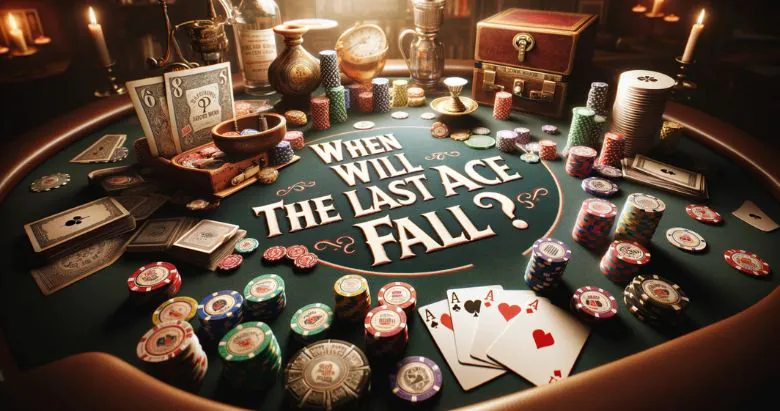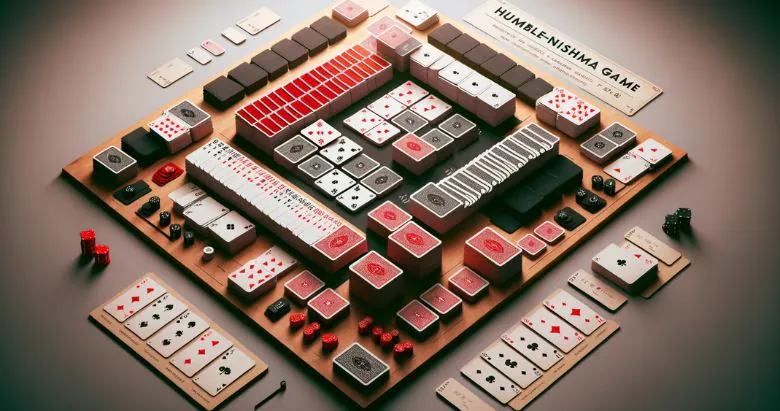How to Guess When the Last Ace Will Fall?

- Fact Checked by: PokerListings
- Last updated on: October 29, 2024 · 6 minutes to read
In modern casinos there is a simple and very popular entertainment: guess when the last Ace in the card deck will fall. The dealer right in front of your eyes shuffles a standard card deck with 4 Aces and starts laying one card on the table at a time. The main task of the player is to guess which position the last Ace will fall. It can be, for example, the 4th position or the 52nd. If you guess the number correctly – you get a huge win!
Despite the fact that the rules of the game seem very clear, it is impossible to quickly come up with a working strategy in this case. As a rule, players most often rely on their luck and intuition or name their favorite number/birthday and so on. But there is one proven scheme that few people know about! The method is very simple – just choose the 52nd card.
Obviously, choosing numbers 1, 2 or 3 is foolish, as there are 4 Aces in the deck. The probability that all of them will go consecutively is incredibly small, which is why number 4 is also a very bad choice. Technically, the last Ace will always be between 4 and 52 cards. For example, you decided to call the number 38. Perhaps this is where the Ace you need will be hiding! However, the probability that this card is the last one is only about 2%. Too much of a risky strategy to lose your own money!
By naming the 52nd card, you will be sure that the potential Ace is definitely the last. After all, there are no more cards!
To comprehend the information a bit better, it is necessary to study a real example on a deck of 6 cards. The task is the same – to determine when the last Ace will fall out. Obviously, it makes no sense to choose the first three cards. The last Ace will be 4, 5 or 6. The cards you need can be in any order, so potentially you have 24 successful layouts. By choosing a number closer to the end of the deck, the chances of winning a cash prize is many times greater!
Americas Cardroom
T&Cs Apply | Play Responsibly | GambleAware
18+ | Play Responsibly | T&C Apply
Unobvious Poker Joker Card Schemes
Every self-respecting amateur poker player knows all card combinations by heart, from Flush Royal to High Card. To inform newcomers in the field, the possible card combinations are presented in the table below:
| Hand | Explanation |
|---|---|
| Royal Flush | The strongest combination in poker. It consists of five cards of the same suit from Ten to Ace. |
| Straight Flush | These are five consecutive cards of the same suit. For example, from the Eight to the Queen. |
| Four of a Kind | Poker combination that contains four cards of the same value. For example, four Sevens. |
| Full House | A Full House contains three cards of the same value and a pair. |
| Flush | Five cards of the same suit in any order. |
| Straight | This combination contains five consecutive cards of different suits. |
| Three of a Kind | Three cards of the same rank. |
| Two-pair | Two sets of cards of same rank (8&8 + K&K) |
| One-pair | A combination of 2 cards of the same rank. |
| High-card | Poker players may sometimes fail to make a single combination. Then the winner is determined by the highest card. The denominations are counted in order. The Ace is the highest card in the deck. |
The principle of card distribution by levels is simple: the less often a combination can appear, the more valuable it is. Just as an example, there are only 4 Royal Flushes, 36 Straight Flushes, 624 Four of a Kind, and the list goes on. In total, there are over 2.5 million possible combinations in poker!
If you play poker with the Joker card you could end up being unspeakably lucky! After all, you can turn it into absolutely any card that will strengthen your combination. So, for example, you can very easily turn the combination of One Pair into Two Pairs or Trips!
Still inn this case the question arises: “How should the gradation of combinations change?“. After all, if the Joker is involved in the game, a combination with 5 identical cards appears. Players often wonder, “What place in the hierarchy will this combination take?”.
Firstly, if you play poker with the Joker card, the number of possible combinations is equal to the number of denominations in the deck. The standard is 13 pieces. The most favorable one, the Royal Flush would no longer be 4 pieces, but 24. Thus, arranging combinations by their probability of occurrence becomes impossible! This is directly related to the combinations of Three of a Kind and Two Pairs.
Take this as an example, the order of combinations remains unchanged: Three of a Kind is greater than Two Pairs. Then, every time a player gets a Joker, a Pocket Card and 2 other cards – he will be strengthened to Three of a Kind. Thus, there are no longer 55, 000 but 137,700 ways for Trips to appear. Obviously, this combination probability now becomes much higher than that of the Two Pairs combination.
If we change the seniority of combinations, it becomes unprofitable for players to collect a Three of a Kind. Accordingly, their number decreases while the Two Pairs combination has too high of a probability of falling out. This is an endless cycle where it is impossible to determine the final outcome.
Humble-Nishiyama’s Scheme on How to Win Big
There is an interesting card game that seems quite simple at first glance. Back in 1969, Walter Penny published the idea in the Journal of Recreational Mathematics. It was originally based on a linked coin drop sequence. A little later, Steve Humble and Yutaka Nishiyama adapted it to a pack of cards.
The game requires a standard 52-card deck, where black and red cards are on a 1:1 ratio. A total of 2 people can participate. The task of the first player is to create a sequence of 3 cards, naming their color. For example “red-red-black”. The suit of the cards does not matter. Then the second player does the same actions. You’re not allowed to turn the cards over and show them to the opponent.
Thus, the participants have 6 cards in their hands. There are 46 cards left in the deck. Next, players must place the remaining cards from the deck onto the table. This is repeated until the combination of the first or second player repeats! The one whose sequence falls out first – wins and takes the cash prize!
At first glance, everything is simple enough, right? However, there is a special mechanism that allows you to win many more more! One of the most popular strategies noted by the authors: “Do not pick three identical cards in a row. The probability of a black card falling out after two of these identical cards is much lower”. This is a simple realization, because due to the equal number of cards, the probability of each card falling out is exactly 50%.
Another important piece of advice from the game’s creators is, “Enter as the second player, not the first!” The first player doesn’t care about the sequences, but the second player can easily adapt his combination and win on it! Take the second player’s card and make it the first card in your own combination!
The Humble-Nishiyama game belongs to the category of non-transitive games. This means that each subsequent choice directly depends on which pair it is made in. In non-transitive games, there is no one correct choice, there are only more or less weighty preferences.
Thus, knowing the choice of the first player, you can choose an alternative option, which in this case is the most profitable. And you will have a huge advantage simply because you entered the game second.
Stake.US Poker
T&Cs Apply | Play Responsibly | GambleAware
18+ | Play Responsibly | T&C Apply
-
- 100% up to $2000
T&Cs Apply | Play Responsibly | GambleAware
18+ | Play Responsibly | T&C Apply
-
CoinPoker4.1
- 33% Weekly
- 150% up to 2000$
T&Cs Apply | Play Responsibly | GambleAware
+18 / T & C apply / Play responsible
-
Stake.US Poker4.3
- Rakeback 5%
- $55 Stake Cash + 260K Gold Coins
T&Cs Apply | Play Responsibly | GambleAware
18+ | Play Responsibly | T&C Apply
-
- 100% up to $1000
T&Cs Apply | Play Responsibly | GambleAware
T&Cs Apply | Play Responsibly | GambleAware
-
T&Cs Apply | Play Responsibly | GambleAware
18+ | T&Cs Apply | Play Responsibly | GambleAware




